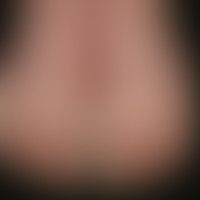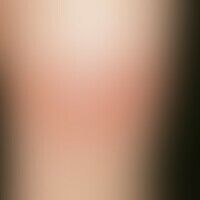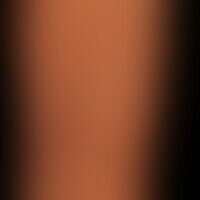Image diagnoses for "Leg/Foot"
395 results with 1158 images
Results forLeg/Foot

Venous leg ulcer I83.0

Bowen's disease D04.9
Bowen's disease with transition to Bowen's carcinoma: solitary, size-progressive plaque that has been present for several years, occasionally accompanied by itching, sharply and arc-shaped, border-emphasized plaque with increasing verrucous knot formation (white encircles the zone with the beginning invasive growth).

Granulomatosis disciformis chronica et progressiva L92.1
Granulomatosis disciformis chronica et progressiva: Large, hyperpigmented, borderline infiltrated foci with atrophic surface.

Psoriasis palmaris et plantaris (plaque type) L40.3
Psoriasis palmaris et plantaris (plaquet type): chronic stationary keratotic plaques on the soles of the feet and toes, in this case spreading to the backs of toes and feet.

Hyperpigmentation postinflammatory L81.0

Artifacts L98.1

Melanoma acrolentiginous C43.7 / C43.7
melanoma malignes amelanotic: since earliest childhood a pigment mark has been known at this site. continuous growth for several years. for half a year extensive ulceration of the node. constant bleeding and oozing. the diagnosis cannot be made on the basis of the clinical picture.

Dermatoliposclerosis I83.1
Dermatoliposclerosis. 64-year-old patient with Z.n. fracture of the distal lower leg after skiing accident 10 years ago and consecutive CVI. For years increasing discoloration and hardening of the distal US third. Extensive hyperpigmentation of the skin with coarse increase in consistency. Flat scaly crusts in the center of the skin change. Small fatty tissue proliferations (piezo nodules) on the heel.

Pyoderma gangraenosum L88
Pyoderma gangraenosum. multiple, chronically progressive, painful, large-area, blue-reddish nodules, partly with polycyclic ulcerations. characteristic is the necrotic ulcer with a painful marginal zone with walllike, undermined margins and dark red, livid erythematous border.

Erythema migrans A69.2
erythema chronicum migrans. shown here is a finding about 3 months old. approx. 10 days after (rememberable) puncture, a painless, non-itching circular erythema developed, only moderately well distinguishable from normal skin. 3 months later the doctor was consulted.

Erysipelas A46
Erysipelas. hemorrhagic blistering and erosions on sharply defined erythema in the area of the foot.

Urticaria (overview) L50.8
Acute urticaria: acutely occurring, itchy exanthema with circulatory, also anular wheals.

Urticaria (overview) L50.8
Acute urticaria: Acute exanthema with multiple red wheals localized on the trunk and extremities, disseminated, flatly elevated, severely itching.

Erythema migrans A69.2
Erythema chronicum migrans, painless, sharply defined, round, red plaque with centrally located yellowish papule (tick bite), existing for 14 days.

Atrophie blanche L95.01









